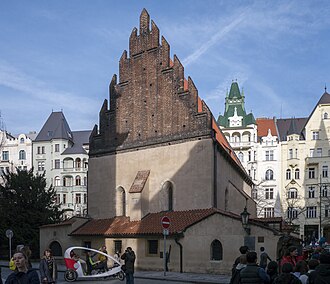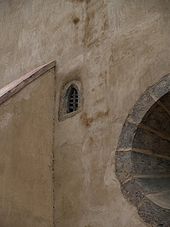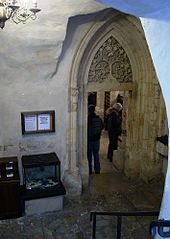Old New Synagogue
The Old New Synagogue or Old New School in Prague's Josefstadt ( Staronová synagoga in Czech ) is the oldest intact synagogue in Europe and one of the earliest Gothic buildings in Prague.
history
The synagogue was built in the early Gothic style in the 13th century and is still the religious center of Prague's Jews today . The building has defied several city fires, Jewish pogroms and the slum rehabilitation (assanierung) of the 19th century. In contrast to the older Old Synagogue in Erfurt and the older, but rebuilt Worms Synagogue , the Old New Synagogue was retained. Originally it was called the “Great” or “New” Synagogue (as opposed to an older, non-preserved house of prayer) until a new building near it received this name.
According to various sources, the building was erected in the last third of the 13th century by stonemasons from the royal building works, who also built the nearby St. Agnes monastery . Another source says that the construction was carried out by a Cistercian construction hut.
In the course of time the building was hardly changed. Josef Mocker only renovated the synagogue in 1883 . In the 20th century, further repairs were carried out in 1921–1926, 1966/1967 and 1998/99. During the time of the German occupation of Prague, the house of prayer was not destroyed by the National Socialists , as the National Socialists planned to transform the synagogue into a museum of the extinguished Jewish race .
The Old New Synagogue was always the main synagogue of Prague's Jewish community and enjoyed a corresponding reputation. Its most important rabbis worked here, such as Eliezer Aschkenasi , Mordechai ben Abraham Jaffe , Rabbi Löw , his pupil Jomtov Lipman Heller , Ezechiel Landau and Solomon Judah Löb Rapoport .
In addition to the High Synagogue and the Jerusalem Synagogue , the Old New Synagogue is one of the three synagogues in Prague where services are still held today. The nearby Klaus and Maisel synagogues , on the other hand, serve as religious museums.
Surname
About the origin of the name "Altneu" there is next to the above. Explanation of various legends too. The name should be derived from the Hebrew עַל תְּנַאי (al tenai), which means "on the condition that". Angels are said to have brought stones from the Jerusalem Temple when the Old New Synagogue was built , "on condition that" they should be given back when the Messiah arrived and the temple was rebuilt. According to another interpretation, however, the remains of an even older synagogue were found when the ground was dug for the construction of the synagogue. The “new” synagogue was then built on the foundation of the “old” one.
According to legend, the clay remains of the golem are in the attic , which Rabbi Löw is said to have enlivened with his spiritual power 400 years ago. According to another legend, angels transformed into doves protected the synagogue from conflagrations, so that it has been preserved to this day, although there were several large fires in the Jewish city. In fact, the Old New Synagogue owes its preservation to the fact that it always stood alone and isolated and was never connected to any other building. As a result, and also because of its very solid construction, it was able to withstand all the vicissitudes of the centuries.
Building description
Location and comparison
The Old New Synagogue is located at Červená 2 in the former Jewish town of Josefstadt and is the oldest undamaged example of a two-aisled medieval synagogue. The synagogue of Worms , which is about 100 years older in plan and shape , was rebuilt in the 1960s after its destruction during the November pogroms in 1938 ; the synagogue of Regensburg, which is also older, no longer exists, the synagogue of Vienna (also destroyed) and the later synagogue were similar in design Krakow Synagogue. The Erfurt synagogue that has been preserved is about the same age.
Architectural and interior design
The isolated building has thick walls with buttresses for reinforcement and only narrow windows. It is surrounded on three sides by low extensions that contain an anteroom and a nave. The floor level is lower than the street level as a sign of humility. The vestibule, dating from the middle of the 13th century, with its pointed arched barrel vault is the oldest component. Here there are two early baroque coffers that are said to have served to take up the Jewish tax that was levied across the country. At the end of the 13th century a two-aisled hall was added. The two stepped brick gables from the 15th century are striking on the facades .
The high main room with an ornate five-ribbed vault made up of six five-capped arches is supported by two octagonal pillars. The twelve pointed arched windows represent the twelve tribes of Israel . The tympanum with a depiction of grape leaves and vines above the richly profiled portal, the tympanum above the Torah shrine with carved leaf ornaments and the vault keystones are particularly valuable .
In the middle of the room - between the two octagon columns - a platform carries the bima , the desk on which the Torah is read, surrounded by a Gothic wrought-iron grille. On the east wall is the Torah shrine, which is covered with parochet and kaporet and in front of it the Ner Tamid . To the right of it is the stone desk for the cantor .
The seats are still placed around the bima along the walls as in their original state. Behind it, niches were left in the walls that were used to store books and prayer implements. The seat of the chief rabbi is raised. There are wall lights on the walls with brass mirrors to intensify the light. The bronze chandeliers date from the 16th to 18th centuries. The walls are also decorated with Hebrew inscriptions and acronyms from Biblical verses.
A large old flag hangs above the Bima, symbolizing the important position of the Prague Jewish community and in its current form from 1716. However, it has been in use since the 15th century and shows the coat of arms of the community, a star of David with a Jewish hat on a red background, on the edges with the inscription of the Jewish creed " Scheme Yisroel ".
See also
literature
- Arno Pařík, Peter Zieschang (German translation): The Jewish Prague. Jewish Museum, Prague 2012, ISBN 80-85608-54-5 .
- Arno Pařík, Terezie Slavíková (German translation): The Prague synagogues in pictures, engravings and old photographs. Státní Židovské Muzeum, Praha (Jewish Museum, Prague) 2005, DNB 890209251 .
- David D. Podiebrad: Antiquities of Prague's Josefstadt, Israelite cemetery, old-new school and other synagogues. Podebrady, Prague 1870.
- Mark Podwal: Stavěno anděly, Příběh staronové synagogy. (Built by Engel, History of the Old New Synagogue), Židovské muzeum , Praha, 2009, ISBN 978-80-86889-86-3 (children's book).
Web links
- The Old-New Synagogue in Prague. In: Allgemeine Bauzeitung, 1886 , ANNO
- Dirk Dähnhardt, Thomas Gransow: Prague and the Hradschin
- The old new school in Prague. : Several legends, such as a detailed description of this synagogue, can be found in the gallery of Jewish curiosities "Sipurim". Publishing house by Wolf Pascheles . Pressure v. F.Šír. Property u. Verlag v. W. Pascheles Prague, [nedatováno]. Židovské pražské muzeum, inv. č. 012.710. Note 275
Individual evidence
- ↑ a b Prague. Olympia travel guide , Olympia Publishing House Prague, 1988; Pp. 107/108
- ↑ City Guide Prague , ed. from ADACe.V., 2008. Here under number 12: Old New Synagogue
Coordinates: 50 ° 5 '24.2 " N , 14 ° 25' 7.1" E



